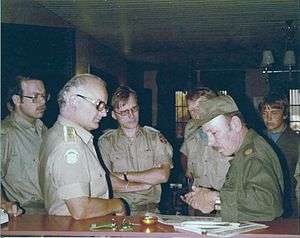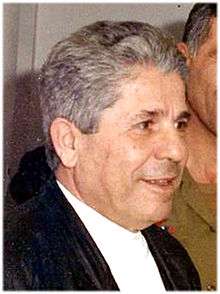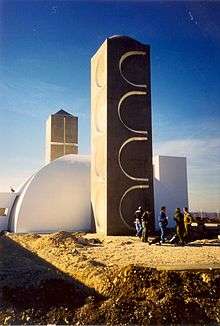South Lebanon Army
| South Lebanon Army جيش لبنان الجنوبي | |
|---|---|
| Participant in Lebanese Civil War | |
| Active | Active as a military force until May 2000; since then, active solely as a political party. |
| Leaders | Saad Haddad, Antoine Lahad |
| Headquarters | Metulla, Marjayoun |
| Strength | 2,700-3,000 men |
| Originated as | 1,200 men |
| Allies |
Lebanese Forces |
| Opponents |
Lebanese National Movement Jammoul |
The South Lebanon Army or South Lebanese Army (SLA) (Arabic: جيش لبنان الجنوبي, transliterated: Jaysh Lubnān al-Janūbi) was a Lebanese Christian militia during the Lebanese Civil War which split from the Army of Free Lebanon. After 1979, the militia operated in southern Lebanon under the authority of Saad Haddad's Government of Free Lebanon.[1] It was supported by Israel during the 1982–2000 South Lebanon conflict to fight against the Palestine Liberation Organisation (PLO) and Hezbollah.
History
In 1976, as a result of the ongoing civil war, the Lebanese army began to break up. Major Saad Haddad, commanding an army battalion in the south which had been part of the Army of Free Lebanon, broke away and founded a group known as the Free Lebanon Army (FLA). The FLA was initially based in the towns of Marjayoun and Qlayaa in southern Lebanon. The FLA fought against various groups including the Palestine Liberation Organization (PLO), the Amal Movement and (after the 1982 Israeli invasion of Lebanon) the emerging Hezbollah. While the group was no longer under the direct control of the Lebanese army, from 1976 to 1979 its members were still paid as Lebanese soldiers by the government.
The 1978 Israeli invasion allowed the Free Lebanon Army to gain control over a much wider area in southern Lebanon. On April 18, 1979 Haddad proclaimed the area controlled by his force "Independent Free Lebanon". The following day, he was branded a traitor by the Lebanese government and officially dismissed from the Lebanese Army. Part of the Free Lebanon Army returned to government control, while Haddad's part split away and was renamed the South Lebanon Army (SLA) in May 1980. Following Haddad's death from cancer in 1984, he was replaced as leader by retired Lieutenant General Antoine Lahad.

The SLA was closely allied with Israel. It supported the Israelis by fighting the PLO in southern Lebanon until the 1982 invasion. After that, SLA support for the Israelis consisted mainly of fighting other Lebanese guerrilla forces led by Hezbollah until 2000 in the "security zone" (the area under occupation after a partial Israeli withdrawal in 1985). In return Israel supplied the organization with arms, uniforms, and logistical equipment.
The SLA hosted the Christian radio station Voice of Hope (established and funded by George Otis, founder of High Adventure Ministries). Beginning in 1982, the SLA played host to Middle East Television (which was also established, funded and operated by High Adventure Ministries). Otis gave Middle East Television (METV) to Televangelist Pat Robertson, founder of CBN. On May 2, 2000 Middle East Television relocated to Cyprus.
In 1985 the SLA opened the Khiam detention center. Torture was a common tactic, and occurring on a large scale. Israel denies any involvement, and claims that Khiam was the sole responsibility of the SLA; this has been contested by human rights organizations such as Amnesty International.[2] The SLA also imposed military conscription, under which males over 18 living in the territory it controlled served one year as military recruits.[3] While the SLA received funding, weapons and logistics from Israel during its existence, the SLA did much fighting independent from Israeli forces. The SLA also handled all civilian governmental operations in Israel's zone of control.

During the 1990s Hezbollah carried out increasingly effective attacks on the SLA, aided in later years by Lebanese army intelligence which had infiltrated it. These changed circumstances led to a progressive loss of morale and members. In 1997, Israel maintained approximately 1,000 to 1,200 troops in southern Lebanon and supported another 2,000 in the SLA.[4] By 2000 the SLA was reduced to 1,500 soldiers, compared to 3,000 ten years earlier. At its peak during the early 1980s, the SLA was composed of over 5,000 soldiers.
Withdrawal, collapse and surrender
The increase in Israeli casualties in Lebanon over the previous few years led to growing domestic pressure for an end to Israel’s military presence in Lebanon. Ehud Barak’s Labor Party pledged during his March 1999 election campaign for Prime Minister to withdraw Israeli troops from Lebanon by July 2000. Barak won a victory in the May 1999 elections. On March 5, 2000 the Israeli cabinet voted unanimously for a full troop withdrawal from Lebanon by July. The expectation then was that such a withdrawal would be part of an agreement with Lebanon and Syria; however, negotiations with Syria broke down.[5][6]
On May 22, Israeli forces unilaterally began handing over their forward positions in the occupied zone to the SLA. As the chaotic nature of the withdrawal became obvious, civilians from the zone overran SLA positions to return to their occupied villages while Hezbollah guerrillas quickly took control of areas previously controlled by the SLA. The SLA in the central sector of the security zone collapsed in the face of the civilians and Hezbollah's rapid advance.[7] The next day, SLA forward positions in the eastern sector collapsed and Israeli forces began their general withdrawal from the remaining areas of the security zone. With the Israeli withdrawal, the SLA collapsed totally. The withdrawal was complete on Wednesday, May 24, 2000; the sight of Saad Haddad's statue being dragged through the streets of the Lebanese town of Marjayoun was a sure sign that the South Lebanon Army was gone.[8]
As the Israeli withdrawal rapidly progressed, SLA militiamen were left with few choices. The Lebanese government, Hezbollah and many civilians in the area considered them traitors and collaborators. In addition, they were told that Israel's border would be closed after the withdrawal. Many were terrified of being captured (and possibly killed) by Hezbollah guerrillas or vengeful mobs, or being jailed or executed by the Lebanese government.
Many members of the SLA (including some with their families) fled to Israel; the Christian majority feared being suspected of serious offences committed by SLA members, and a number of members were reportedly granted asylum in European countries (primarily Germany). Others who remained in Lebanon surrendered to authorities or were captured by Hezbollah and handed over to the police. SLA members captured by Lebanon and Hezbollah were tried by Lebanese military courts for treason.
Israeli prime minister Ehud Barak was criticized in Israel by the Jewish settler movement on the grounds that his decision to withdraw without consulting his SLA allies led to the speed and confusion of its collapse.[5] Hezbollah was criticized for preventing the arrest of some members of the SLA; it justified this on the grounds that it was in a position to know who among them had been informants.[9]
By the next month (June 2000), 3,000 former SLA members were in the custody of the Lebanese government; by the end of the year, about 90 percent had been tried in military courts. It has been estimated that a third of the SLA members were sentenced to less than a month and another third received one-year sentences. Two members of the SLA accused of torture at Al-Khiam prison received life sentences. The death sentence was recommended for 21 SLA members, but in each case the military reduced the sentence. Certain other individuals were barred from returning to Southern Lebanon for a number of years.[10]
Of those who initially fled to Israel, many SLA members and their families eventually chose to return to Lebanon after Hezbollah promised they would not be harmed. Others accepted Israel's offer of full citizenship and a financial package similar to that granted new immigrants, and settled permanently in Israel. On April 6, 2006 the Israeli Knesset Finance Committee approved the payment of 40,000 shekels per family to SLA veterans, payable over seven years.[11] Many of the SLA fighters who settled in Israel later moved to the United States and Europe. Some 2,700 SLA fighters and family members live in Israel today. They are mainly concentrated in Nahariya, Kiryat Shmona, Tiberias, Ma'alot-Tarshiha, and Haifa.[12]

Israel continues to host the Government of Free Lebanon, on whose behalf the SLA had operated. The Government of Free Lebanon has operated from Jerusalem since 2000, and still claims to be the true government of Lebanon.
Field organization
The SLA was organized into two regions (western and eastern), each with its own infantry brigade. Each brigade consisted of three battalion-sized infantry regiments; the strength of support included several heavy-artillery batteries (155 and 130mm), subdivided into the infantry battalions as needed. There was also an armored regiment of 55 tanks.
This force manned 46 locations along the front (from Naqoura in the west to the eastern slopes of Mount Hermon), while the Israeli Army had 11 centers, mostly in the rear lines.
The SLA Security Service consisted of 250 officers and men, tasked with:
- Counter-espionage by outside forces
- Border security
The service included field and intelligence officers, investigators, intelligence analysts, administrative personnel, security officers and guards.
Equipment
- Infantry weapons
- IMI Uzi
- IMI Micro Uzi
- FN FAL 50-00
- AK-47/AKM Kalashnikov
- H&K G-3
- IMI Galil
- Colt M16A-1/2
- Colt CAR-15
- FN FAL H-BAR
- FN MAG 60-00
- RPD
- PKT
- Browning M1919A4
- Browning M2HB
- IMI Negev
- IMI IS-10 smoke grenade launcher
- Colt M203
- IMI 52mm mortar
- IMI 60mm mortar
- IMI 81mm mortar
- M-43 82mm mortar -some SP on M3 Half track
- Main battle tanks
- 7 Patton M48A5 105mm MBTs
- 34 improved IMI T-54/T-55 Tiran-4/5 100mm/L-7 105mm MBTs[13]
- 20 improved IMI Super Sherman M-50(15)/M-51[13]
- Light tanks
- Giat AMX-13 75mm LTs (ex-Lebanese Army)
- Charioteer FV4101 MK-IV 20PDR 84.6mm LTs (ex-Lebanon Army)
- Armoured cars
- Panhard AML-90 90mm 4x4 ARVs (ex-Lebanese Army)
- IAI/Ramta RAM-2V 4x4 ARVs
- IAI/Ramta RBY-2 4x4 ARVs
- Armoured personnel carriers
- 20 M113A-1.[13]
- 20 GAZ BTR-50
- 10 GAZ BTR-60 8x8 APCs[13]
- GAZ BTR-152 6x6
- 50 M3/M9 Half-truck/Zahlad (some with ACAV)
- AMX-VCI AIFVs
- AM General Humvee 4x4
- Sherman M50 APC
- Converted T55 APCs /
- Anti-tank weapons
- 9 MBDA Milan ATGM Launcher/75 missiles
- BGM-71A/C Tow ATGMs
- AT-3 Sagger
- M72 Law light ATRLs
- IMI B-300 light ATRLs
- RPG-7
- M40A1C-1 106mm RCLs
- D-48 85mm towed anti-tank gun
- Artillery
- 6 BM-21 Grad 122mm MRLs
- 5 model M50 155mm towed howitzer[13]
- 5 M-46 130mm towed gun[13]
- 10 D-30 122mm towed howitzer[13]
- 20 M-66 160mm SP-Heavy mortar Makmat[13]
- Soltam 120mm Heavy mortar (some SP on M-3 half-truck)
- Missiles
- Kilshon AGM-45 Shrike missile launcher on Super Sherman M51
- Anti-aircraft weapons
- SA-7 Grail MANPADs (ex-Lebanon Army).
- TCM-20 2x20mm AAGs (Some SP on M3 half truck)
- ZU-23 2x23mm AAGs
- Logistic and engineering equipment
- M113/M579 Fitter APC
- M3 Half-truck Fitter-Eyal
- M32 Super Sherman recovery tank
- M50 Super Sherman Ambulance Tank
- BTR-152 Fitter 6x6
- BTR-152 6x6 towing APC
- T-55 Instractor training tank
- M50 Super Sherman Instructor training tank
- IMI Nochri Mine clearing
- IMI KMT
- IMI Dozers (for MBTs/APCs)
- M-325 Towing- command car
- M54A2 truck with crane
- M149 Trailer
- M3 "Half-Track" compressor
- M3 "Half-Track" Gichner Ramim communication APC
- D-8H Bulldozer
- Vehicles
- Ford M151A2 jeep
- Dodge M38
- Toyota Land Cruiser
- Land Rover Defender
- AIL M-325 Command-car
- Dodge WC51
- GMC CCKW
- Dodge M37
- Mercedes Benz Unimog
- REO M35
- M54A-2
- Mercedes Benz Safary troop carrier truck
- MAN trucks
- Other Equipment
- Tadiran Radio equipment
- M845 SLS night vision equipment
- Trainer seats for M50/T55
- Projectors
- Lighthouse
- OR-201 helmets
- M-1 Israeli helmets
- OR-602 helmets (tank crew members)
- Bulletproof vests
- Aircraft
- Cessna 206 turbo Stationair
- Helicopters
- Patrol craft
See also
- Army of Free Lebanon
- Jammoul
- Lebanese Army
- Lebanese Forces
- Lebanese Front
- Sabra and Shatila massacre
- UNIFIL
- Weapons of the Lebanese Civil War
Footnotes
- ↑ Government of Free Lebanon in exile
- ↑ Amnesty International
- ↑ https://www.hrw.org/reports/1999/lebanon/Isrlb997-04.htm#P515_123090
- ↑ US State Department Congressional Testimony, June 25, 1997
- 1 2 Jerusalem Journal Israel's Withdrawal From Lebanon
- ↑ War on Lebanon Edited by Nubar Hovsepian Section 4 by Lara Deeb p 61
- ↑ Domont and Charrara, Le Hezbollah: un mouvement Islamo-nationaliste
- ↑ BBC News Bitter retreat for the SLA
- ↑ Palmer-Harek, Judith, Hezbollah: the Changing Face of Terrorism, London, IB Tauris.
- ↑ "Country Reports on Human Rights Practices". US State Department. 6 April 2001. Retrieved 2006-04-06.
- ↑ "Knesset okays grants to SLA families". Jerusalem Post. 6 April 2006. Retrieved 2006-04-06.
- ↑ http://www.ynetnews.com/articles/0,7340,L-3893238,00.html
- 1 2 3 4 5 6 7 8 "Trade Registers". Armstrade.sipri.org. Retrieved 2013-06-20.
Bibliography
- Ahron Bregman, Israel's Wars: A History Since 1947, Routledge, London 2002. ISBN 0-415-28716-2
- Frédéric Domont and Walid Charrara, Le Hezbollah: un mouvement Islamo-nationaliste, Editions Fayard, Paris 2004. ISBN 2-213-62009-1 (in French)
- Beate Hamizrachi, The Emergence of South Lebanon Security Belt, Praeger, New York 1984.
- Harald List, Ein Land im Fadenkreuz: Der Südlibanon zwischen Armeen und Milizen, Freiburg (o.D., ca. 1991) (in German)
- Harald List and Antoine Lahad, in ORIENT 2/88 S. 179-187.
- Judith Palmer-Harek: Hezbollah: the Changing Face of Terrorism, IB Tauris, London 2003.
- Moustafa el-Assad, Blue Steel 2: M-3 Halftracks in South Lebanon, Blue Steel Books, Sidon 2006.
- Moustafa el-Assad, Blue Steel III: M-113 Carriers in South Lebanon, Blue Steel Books, Sidon 2007.
- Moustafa El-Assad, Blue Steel IV: M-50 Shermans and M-50 APCs in South Lebanon, Blue Steel books, Sidon 2007.
- Moustafa El-Assad, Civil Wars Volume 1: The Gun Trucks, Blue Steel books, Sidon 2008. ISBN 9953-0-1256-3
External links
- The Official Website of the South Lebanese Army.
- Web site devoted to SLA and military vehicles
- The website of the Government of Free Lebanon in Exile
- Photos of the withdrawal from BBC
- BBC Article
- The quandary of an SLA amnesty by Nicholas Blanford, The Daily Star, August 16, 2005.
- Analysis: Role of the SLA by Martin Asser, The BBC news, 23 May 2000.